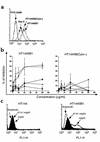Modulation of tumor growth by inhibitory Fc(gamma) receptor expressed by human melanoma cells
- PMID: 12438452
- PMCID: PMC151807
- DOI: 10.1172/JCI15454
Modulation of tumor growth by inhibitory Fc(gamma) receptor expressed by human melanoma cells
Abstract
The efficacy of anti-tumor IgG reflects the balance between opposing signals mediated by activating and inhibitory Fc(gamma) receptors (Fc(gamma)Rs) expressed by effector cells. Here, we show that human malignant melanoma cells express the inhibitory low-affinity Fc(gamma) receptor Fc(gamma)RIIB1 in 40% of tested metastases. When melanoma cells were grafted in nude mice, a profound inhibition of Fc(gamma)RIIB1 tumor growth that required the intracytoplasmic region of the receptor was observed. IgG immune complexes (ICs) may be required for this inhibition, since sera from nude mice bearing tumors contained IgG that decreased the proliferation of Fc(gamma)RIIB1-positive cells in vitro, and tumor development of Fc(gamma)RIIB1-positive melanoma lines was not inhibited in antibody-defective severe combined immunodeficiency (SCID) mice. Passive immunization of SCID mice with anti-ganglioside G(D2) antibody resulted in significant inhibition of growth of Fc(gamma)RIIB1-positive tumors in an intracytoplasmic-dependent manner. Altogether, these data suggest that human melanoma cells express biologically active inhibitory Fc(gamma)RIIB1, which regulates their development upon direct interaction with anti-tumor antibodies. Therefore, Fc(gamma)R expression on human tumors may be one component of the efficacy of antibody-mediated therapies, and Fc(gamma)R-positive tumors could be the most sensitive candidates for such treatments.
Figures






References
-
- Ravetch JV, Bolland S. IgG Fc receptors. Annu Rev Immunol. 2001;19:275–290. - PubMed
-
- Amigorena S, et al. Cytoplasmic domain heterogeneity and functions of IgG Fc receptors in B lymphocytes. Science. 1992;256:1808–1812. - PubMed
-
- Van den Herik-Oudijk IE, Capel PJ, van der Bruggen T, Van de Winkel JG. Identification of signaling motifs within human Fc gamma RIIa and Fc gamma RIIb isoforms. Blood. 1995;85:2202–2211. - PubMed
-
- Fridman WH, et al. Structural bases of Fc gamma receptor functions. Immunol Rev. 1992;125:49–76. - PubMed
-
- White CA, Weaver RL, Grillo-Lopez AJ. Antibody-targeted immunotherapy for treatment of malignancy. Annu Rev Med. 2001;52:125–145. - PubMed
Publication types
MeSH terms
Substances
LinkOut - more resources
Full Text Sources
Other Literature Sources
Medical
Molecular Biology Databases

